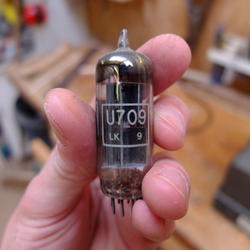Good afternoon all,
I've been humming and hahing for a while now as to whether I should strip out an old valve oscillator and give it a new lease of life as a guitar amp. It's such a well made thing I've been loathe to put it under the knife - as it were - especially as it's still going strong. Trouble is, I have no use for it (my dreams of setting up my own BBC Radiophonics Workshop and becoming the new Delia Derbyshire having been shelved, for now... ), so probably better it gets used for something, than gathers dust in a corner of the workshop.
), so probably better it gets used for something, than gathers dust in a corner of the workshop.
The question is, what sort of amp to build from it?
Pertinent info includes, but is not limited to:
-290VDC B+
-230VDC B+1
The heaters are wired for (left to right):
-1xEF86
-1xEL84
-1xECC83
-2xEL84
Naturally, the order could be easily changed (the EL84 next to the EF86 will have to go), but it's so neatly wired it seems a shame to change more than I have to.
It has a U709 rectifier, which I think is equivalent to an EZ81.
Any suggestions? I'm leaning towards something Vox-like, the EF86 and EL84's being common in early Vox amps. The EF86 has a bad rep for reliability, but I'll not be touring with it - I'm hoping a carefully designed layout should minimise the risks?






Thanks for looking,
Matt.
I've been humming and hahing for a while now as to whether I should strip out an old valve oscillator and give it a new lease of life as a guitar amp. It's such a well made thing I've been loathe to put it under the knife - as it were - especially as it's still going strong. Trouble is, I have no use for it (my dreams of setting up my own BBC Radiophonics Workshop and becoming the new Delia Derbyshire having been shelved, for now...
The question is, what sort of amp to build from it?
Pertinent info includes, but is not limited to:
-290VDC B+
-230VDC B+1
The heaters are wired for (left to right):
-1xEF86
-1xEL84
-1xECC83
-2xEL84
Naturally, the order could be easily changed (the EL84 next to the EF86 will have to go), but it's so neatly wired it seems a shame to change more than I have to.
It has a U709 rectifier, which I think is equivalent to an EZ81.
Any suggestions? I'm leaning towards something Vox-like, the EF86 and EL84's being common in early Vox amps. The EF86 has a bad rep for reliability, but I'll not be touring with it - I'm hoping a carefully designed layout should minimise the risks?






Thanks for looking,
Matt.







Comment